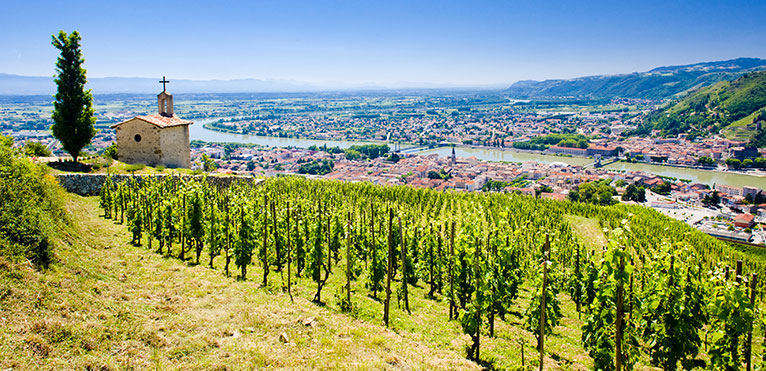
Contents
Beaumes-de-Venise is a wine appellation in the Rhône Valley. This appellation produces mainly red wines, but also rosé and white wines.
Beaumes-de-Venise is recognized by an Appellation d’Origine Contrôlée (AOC), giving it a stable heritage appreciated by wine lovers. Red wine production is limited to 19,100 hectoliters per year, with a yield of 38 hectoliters per hectare; white wine production is limited to 12,000 hectoliters, with a yield of 30 hectoliters.
Beaumes-de-Venise, a rich history gradually gaining in popularity
The geological particularities of the Rhône Valley region explain its richness. The region’s caves give their name to the wine, “beaumes” meaning “caves” and “Venise” referring to the region’s pontifical past. Around a hundred winegrowers work in this area, and have seen the wine evolve and gain recognition over the years: Beaumes-de-Venise was first awarded AOC Vin doux tranquille in 1943, then became a Cru de la Vallée du Rhône in 2005.
The Beaumes-de-Venise Appellation d’Origine Contrôlée has two branches: AOC Beaumes-de-Venise and AOC Vin doux naturel Muscat de Beaumes-de-Venise.
Beaumes-de-Venise white is a mellow wine, highly concentrated in sugar and alcohol; sweetness due to prematurely interrupted fermentation.
Soil diversity, a guarantee of Beaumes-de-Venise vineyard quality
The Beaumes-de-Venise vineyards are located near the Châteauneuf-du-Pape, Châtillon-en-Diois, Clairette-de-Die, Clairette-de-Bellegarde and Costières-de-Nîmes vineyards. The region’s Mediterranean climate favors production, and the relief protects the vines from the wind and allows them to face south. The climate oscillates between very hot, dry seasons and rainy ones. The vineyard covers 660 hectares for the reds and 400 hectares for the whites.
The appellation’s geological richness is due to its diversity: three types of rock make up the terroir. The soil is sandy-clay-limestone, thanks to Triassic soils, Cretaceous Terres Blanches and Jurassic Terres Grises.
This geological diversity, coupled with an extremely rigorous harvest (the vines are hand-picked and systematically sorted), makes it possible to produce this exceptional wine.
The impressive originality of Beaumes-de-Venise
Beaumes-de-Venise is produced as a blend of red wines, with Grenache in the majority, followed by Syrah and sometimes Mourvèdre. White grape varieties may be added, but only below 10% of the blend, giving the wine a certain originality, often the producer’s signature.
Beaumes-de-Venise red wines have an intense color thanks to the Syrah grape variety, generally cherry-red that extends to crimson when the wine is young. The predominantly Grenache noir grape offers notes of red fruit, spice and licorice, followed by animal notes as the wine ages. Mourvèdre aromas are more complex, with a background of leather and undergrowth.
Beaumes-de-Venise white has a limpid color with golden highlights. The bouquet offers aromas of yellow and exotic fruits, amplified by fresh flowers and citrus nuances.
On the palate, the red is full-bodied, high in alcohol, with fine tannins. The fruit is easily detectable on the palate, accompanied by herbs and occasional wood, offering an impressive caudalie. The white is extremely fresh, with a long finish enhanced by honey and fruit, without weighing down the palate.
Beaumes-de-Venise red can be described as a wine for laying down, with an ageing potential of up to twenty years.
Between meat and dessert, Beaumes-de-Venise, a faithful ally
The power of Beaumes-de-Venise reds and the softness of whites make this wine a perfect accompaniment to a wide variety of dishes. Red goes well with game, lamb and beef dishes, such as tajines, beef tenderloin or duck breast. White wines are ideal for desserts, to accompany chocolate, or as an accompaniment to foie gras and spicy dishes.
Beaumes-de-Venise blanc is also used in cocktails, demonstrating its originality and versatile nature.
Beaumes-de-Venise’s exceptional years
Like all wines, Beaumes-de-Venise has seen some exceptional years. These are 1961, 1985, 1988 and 2005. The vintages of the century belong to the years 1990 and 2000. Finally, the vintages of the millennium are 1929, 1978, 1989 and 1998.
Two exceptional estates in Beaumes-de-Venise
Domaine de Cassan
At the foot of the Dentelles de Montmirail, Domaine de Cassan is run by the Croset family, who place responsible agriculture at the heart of their ethical values, while developing a highly appreciated wine tourism business. The nineteen-hectare sun-drenched vineyard attracts wine lovers, who can appreciate the Grenache, Mourvèdre, Cinsault and Syrah varieties. Since 2010, the owner’s sons, Jean-Charles and Vincent Croset, have taken over the estate and are contributing to the development of Beaumes-de-Venise.
Domaine des Bernardins
The Domaine des Bernardins has an illustrious history: a monastic vineyard belonging to the Order of the Bernardins, already praised by Henri IV. The inhabitants of the city of the Popes were not shy about enjoying it either. It was family member Louis Castaud who contributed to the classification of Muscat de Beaumes-de-Venise as an AOC in 1945, a move that greatly benefited the wine’s popularity. The estate is committed to traditional production, refusing the sometimes abusive use of technology, which gives it a spirit of terroir and respect for nature.
Discover the best winemakers of Beaumes de Venise.